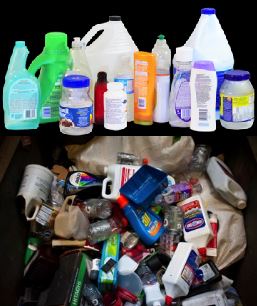Detection and Separation of Recyclable Plastics from Municipal Solid Waste (Year 1)
This project aims to construct a prototype of polymer resin identification system based on mid-infrared (MIR) reflection spectroscopy. The MIR reflectance spectrum contains the chemical information of the material. This fingerprint, in contrast to the popular near-infrared (NIR) spectroscopy, contains much more molecular vibrational resonance information, which we will use to construct a multi-spectral and multi-dimensional library of all plastics commonly encountered in the municipal solid waste stream.
[Project continues into Year 2]
Motivation
The US EPA estimated that among 258 million tons of municipal solid waste (MSW) generated in 2014; plastic accounted for about 33 million tons (1). Worldwide plastics represent 35% of MSW. Despite a focused effort on diverting plastics from the waste stream, recycling rates in the US for PET bottles are 31.3% and for HDPE, 28.2% (1). The additional 14 plastic types commonly found in MSW are recovered and recycled at much lower rates. Recovery and recycling of plastics is important because plastic waste is generated at high rates (mostly from single-use objects), it relies largely on a nonrenewable material for production, it has high energy content, and, if placed in a landfill or improperly disposed of, plastic will resist degradation for centuries (2). Communities are providing more opportunities to separate plastics and appropriately dispose of them to increase recovery and recycling efficiency. These typically rely on the consumer to make correct decisions regarding disposal. The ability to more efficiently identify and communicate the resin used to produce the plastic object will ensure maximum accuracy in disposing of waste materials whether it is at the curb, at a receptacle in shopping centers, institutions, or business, or while separating materials in a materials recovery facility.
Goals and Objectives
The goal of this project is to translate the laboratory-proven MIR spectroscopy method for detecting and differentiating polymer resins to a field deployable system and to test this system under field conditions. The key objectives of the research are:
- Examine the effect of plastic contamination, as commonly encountered in MSW streams, and variable composition and fillers on the efficiency of the proposed multi-spectral infrared detection technique,
- Adapt the laboratory setup to field-compatible configuration,
- Algorithm identification upgrade to minimize the detection uncertanties, and
This project will provide a new technology for the detection and separation of multiple types of plastics with direct application to the recycling process. The technology will improve the effectiveness of recycling and increase diversion from landfills especially for plastics without a RIC. With improved detectability, the plastic types that are poorly recycled can be recovered at greater rates (e.g., plastic film, polystyrene, polypropylene), ensuring a more reliable stream for plastic markets.
Scope of Work
Task 1. Sample Collection. The objective of this task is to evaluate the efficiency of our proposed integrated hand-held device under different type of plastic resins. Plastic samples will be randomly collected from UCF offices and research team homes with the aim to gather as much diversity as possible in order to cover most of the plastics that end consumers dispose, as those in Figure 1. At least fifty samples of each polymer (1-7 RIC plastics) will be desired in order. Items will remain as is without further sample preparation in order to account for common contaminants mixed, for example, during the disposing process. Contamination will be determined by weighing, cleaning, and reweighing plastics. The ability of the MIR-FTIR system to differentiate plastic types will be compared before and after cleaning. In addition, our existing plastic library will be expanded to account for the diversity of the samples, especially fillers, and to establish the detection tolerances.

found in household trash and in MSW.
Task 2. Infrared spectrometer integration in hand-held device. The laboratory-scale measurement setup based on MIR-FTIR spectroscopy has proven to provide reliable identification of unknown plastic resins. The aim of this task is to integrate the previously demonstrated concept in a compact footprint and, at the same time, ensure the high signal to noise ratio needed for accurate identification of contaminated plastic samples is available under field conditions. This task requires design of a higher numerical aperture optical system for delivery and collection of the optical signal and high power IR source, which will be procured from top spectrometer manufacturing companies such as Bruker Optics or Agilent Technologies.
Task 3. Optimization of the identification algorithm. The first-order approximation is to search and match the spectral features found in the reflectance spectra with those stored in the multi-resonance library. However, as the library expands, especially when considering polymer resin blends or fillers or in the presence of pollutants the measured spectra will deviate. In order to compensate for this anticipated effect we will upgrade the identification mechanism based on neural networks, the multilayer perceptron for example, where uncertainties can be reduced to its minima. As a result, the whole systems will become in a robust identification system with high tolerances upon unknown variables different from the sole plastic resin.
| Task | Q1 | Q2 | Q3 | Q4 |
| Task 1: Sample collection: | ✔ | ✔ | ||
| Task 2: Infrared spectrometer integration. | ✔ | ✔ | ✔ | |
| Task 3: Identification algorithm upgrade | ✔ | ✔ |
TAG Meetings
First TAG meeting
November 1st 2018, 10:30AM to 12:00PM.
University Tower, Room 231. University of Central Florida
12201 Research Parkway, Orlando FL 32826.
Presentation video recording [link here].
Progress Reports
Acknowledgement
This project is supported by the HINKLEY CENTER